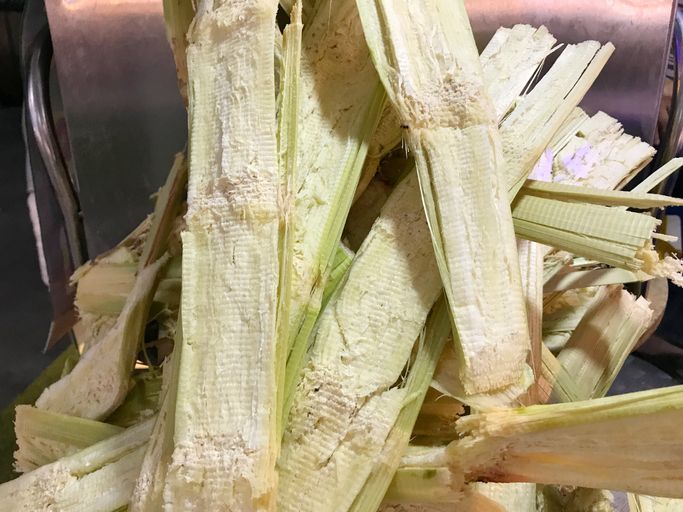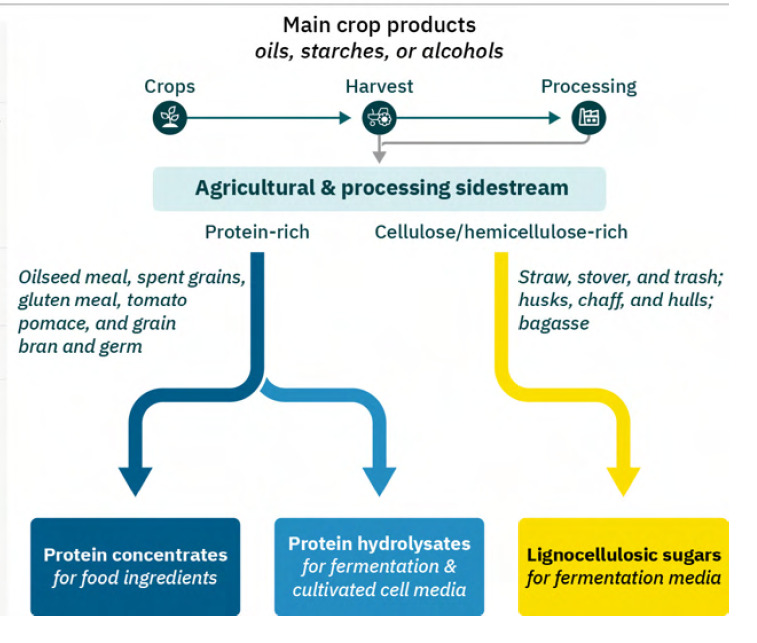Could the sustainability credentials—and the unit economics— of alternative proteins be improved by tapping into side streams from the food and agriculture industry?
Right now, for instance, startups producing high-value ingredients from microbes (yeast, bacteria, fungi) via precision fermentation are using less water and agricultural land than firms producing the same ingredients from animals or plants.
But most of their microbes are still fed with corn sugar, which comes with its own environmental footprint, prompting interest in more sustainable feedstocks that are upcycled from ag side streams such as sugar bagasse or fermentation systems that use carbon dioxide, rather than sugar, as a carbon source.
Today, just a quarter of the biomass of high-volume crops in North America is used for human consumption or other industrial uses (such as ethanol), according to a new report from the Good Food Institute (GFI). The rest (think wheat straw, tomato pomace, spent grains, corn stover, etc.) ends up in animal feed or forage, landfill or incinerators.
Many of these side streams contain proteins and fibers that could be utilized directly in human foods; fermentable sugars that could serve as feedstocks for precision fermentation; and protein hydrolysates that could be used in cell culture media for cultivated meat or microbial fermentation.
However, high costs and technical challenges still present roadblocks to commercialization, says the GFI.
Some examples of food & ag side streams include:
- Sugarcane bagasse (the fibrous pulp left over after crushing sugarcane): Tokyo-based Toray (see below) hopes to commercialize cellulosic sugar from bagasse by 2030.
- Corn stover (leaves, stalks and cobs left in the field after harvest): Used as a source of fermentable sugars in some ethanol production facilities, a food-grade fermentation processes utilizing the sugars in corn stover “would likely require a more purified sugar stream” speculates the GFI.
- Brewers’ spent grains (a protein- and fiber-rich byproduct of beer production): Several startups are now using spent grains as a source of high-value food ingredients.
- Tomato pomace (what’s left over after processing tomatoes for juice, ketchup, soup): Requires on-site drying given its high moisture content.
- Rice hulls (separated from rice grains during the milling process): Rice hulls have a high cellulose and hemicellulose content, making them a potentially interesting source of fermentable sugars for microbial fermentation. However, they also contain silica, which could impact the saccharification process (where enzymes break cellulose down into simpler sugars) and require removal before processing, increasing pre-treatment costs, says the GFI.

Ranking valorization opportunities
The GFI analyzed the major agricultural side streams from the top crops produced in North America, and evaluated the upcycled ingredients they might yield by composition (sugar type, protein content and quality, etc.). It then modeled the forecasted volume and production costs of the ingredients and ranked the resulting valorization opportunities.
- Protein concentrates for plant-based meat, dairy or other products: The top economic candidates were soy meal, canola meal, wheat bran, tomato pomace, wheat gluten, rice bran, and barley brewers’ spent grains (BSG), multiple ingredients from which have already been commercialized. When considering economic, environmental, and protein digestibility factors, corn distillers’ dried grains with solubles (DDGS) and corn gluten meal emerged as other promising candidates.
- Protein hydrolysates for fermentation or cultivated meat media (as a source of nitrogen and amino acids): The top economic candidates were soy meal, corn DDGS, canola meal, barley BSG, and corn gluten meal. When combining economic and environmental factors, the top candidates were soy meal, corn gluten meal, corn DDGS, and tomato pomace.
- Lignocellulosic sugars for microbial fermentation: The top economic candidates were corn stover, soy straw, and rice hulls. When combining economic and environmental factors, barley straw, barley husks, and sugarcane trash/bagasse moved up the list.
Fermentable sugar sources
Lignocellulosic sugars—sugars contained in agricultural side streams such as sugarcane bagasse and corn stover—have long been touted as a greener and potentially cheaper source of fermentable sugars than corn sugar-based products such as DE95.
These sugars can be extracted through a pretreatment step to break down lignin, followed by enzymatic hydrolysis of cellulose and hemicellulose. This process, known as saccharification, yields a mixture of fermentable hexose sugars such as glucose and pentose sugars such as xylose.
However, costs remain a challenge, said the GFI. “The modeled total fermentable sugar costs for these top candidates ranged from $320 to $550 per metric ton of sugar, while the modeled glucose-only sugar extraction costs ranged from ~$550 to $880 per metric ton of glucose.”
To place this in context, many commercial fermentation processes utilize lower-grade DE95 dextrose syrup, which had a bulk price in 2020 of $400/metric ton or ~$560 per metric ton for glucose alone.
However, “These [lignocellulosic] sugars could become cost-competitive through optimized extraction processes and incentives for their use over food crops,” says the GFI. “Additionally, the mixed sugar composition of these feedstocks should be utilized to its fullest potential by the microorganism.
“Access to and efficient use of lignocellulosic sugars could also be unlocked through novel [microbial] strain selection and strain development that leads to efficient, simultaneous use of all reducing sugars (glucose and xylose) present in these feedstocks.”

Challenges and opportunities
A challenge impacting many of the side streams explored in the report is a lack of infrastructure to ensure the stream is preserved and stabilized before key ingredients can be extracted, especially if the source material has a high moisture content, notes the GFI.
“For side streams that can quickly spoil from rancidity or suffer contamination by microbial growth, food manufacturers will need to strongly consider the physical proximity of their processing facilities to side stream producers and the distribution management of getting raw materials to these facilities.”
As many of these side streams do not have mature value chains, their use as alternative protein inputs has yet to be optimized, leading to high costs and low recoveries, adds the GFI.
However, “Improving pretreatment processes, enzyme costs, and enzymatic efficiencies will help. Thus, economically sourcing enzymes, such as cellulases, and finding or engineering enzymes with superior activities, such as proteases, would improve ingredient techno-economics.”
Players to watch:
- The Supplant Company [disclosure: an AgFunder portfolio company]: Producing low-glycemic sugar replacements and flours from upcycled agricultural side streams such as wheat straw.
- Comet: Extracting the prebiotic fiber arabinoxylan from wheat straw.
- Terra Bioindustries: Producing mild-tasting barley protein concentrate and fermentable sugars from upcycled spent grains.
- EverGrain: Producing mild-tasting barley protein isolates from upcycled spent grains.
- Hyfé: Transforming sugary food processing wastewater into feedstocks for biomanufacturing.
- Toray: Working with Mitsui DM Sugar Co to test technology it claims can radically improve the economics of cellulosic sugar production.
- DSM: Producing a canola protein isolate extracted from the meal byproduct of canola oil production
Click here to download the GFI report: ‘Cultivating alternative proteins from commodity crop side streams.’




